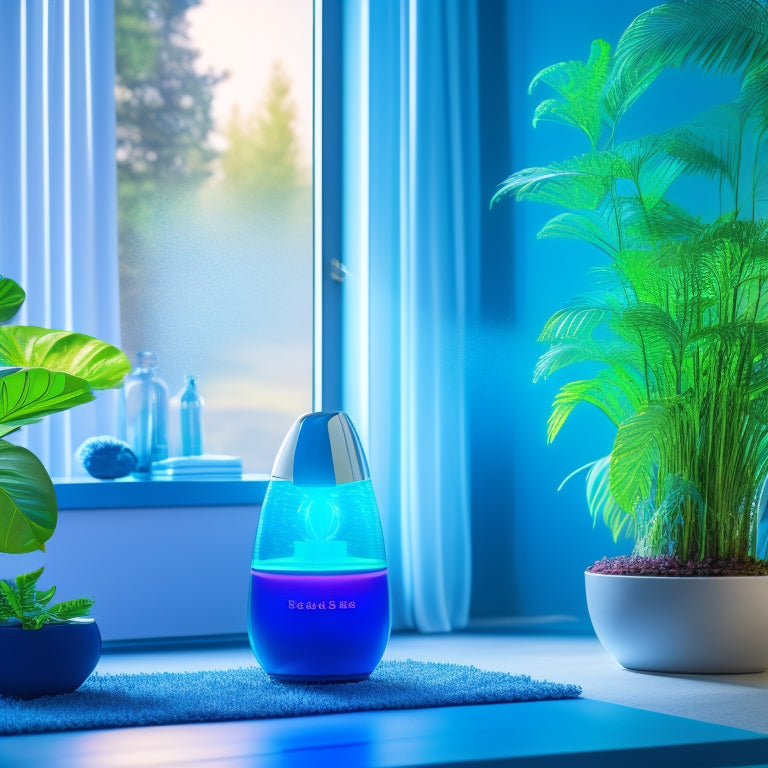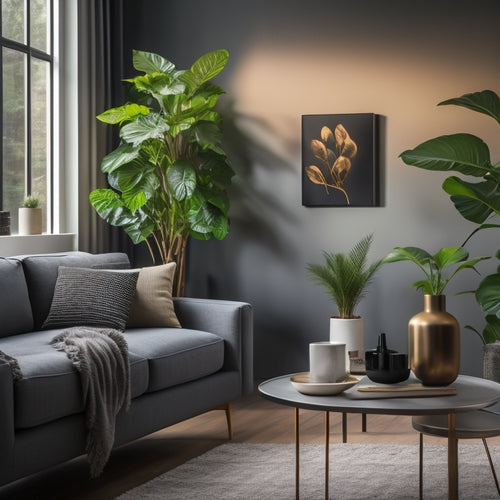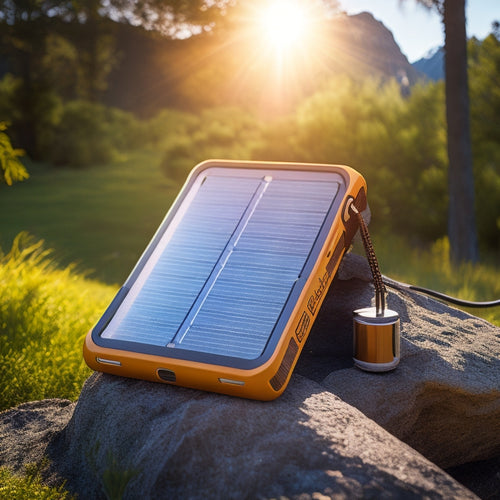
Why Are Ultraviolet Purifiers Effective Against Germs
Share
Ultraviolet purifiers are effective against germs primarily because they employ UV-C light to target and inactivate pathogens by disrupting their DNA and RNA. This process can eliminate up to 99.9% of harmful microorganisms, including bacteria and viruses, based on numerous laboratory tests. The germicidal effectiveness of UV light varies with exposure duration and intensity, emphasizing the importance of proper device specifications and room size for maximum impact. Additionally, these purifiers enhance indoor air quality by removing allergens, contributing to a healthier living environment. There's much more to uncover about optimizing UV technology for safety and efficiency.
At a Glance
- UV-C light disrupts the DNA and RNA of pathogens, effectively inactivating them and preventing their reproduction.
- Laboratory tests show UV-C light can inactivate up to 99.9% of various bacteria and viruses, including E. coli and MRSA.
- UV purifiers eliminate airborne allergens and pathogens, improving indoor air quality and promoting respiratory health.
- The effectiveness of UV purification varies with exposure dose, with higher doses resulting in better germicidal action.
- UV purifiers operate with lower energy consumption than traditional methods, making them an eco-friendly choice for disinfection.
Proven Germicidal Effectiveness
When you consider UV-C light's germicidal effectiveness, it's vital to understand its mechanism of action.
Laboratory tests consistently show that UV-C light can inactivate a wide range of pathogens, demonstrating its reliability as a disinfection method.
UV-C Light Mechanism
UV-C light's germicidal effectiveness is rooted in its ability to disrupt the DNA and RNA of microorganisms. When you expose these pathogens to UV-C radiation, the light penetrates their cellular structure, causing irreparable damage to their genetic material. This disruption prevents them from replicating, effectively neutralizing their threat.
In various UV-C applications, such as water purification and air sterilization, the intensity and duration of UV-C exposure are critical. Different microorganisms require varying doses to achieve effective germicidal action. Understanding these parameters guarantees you maximize the benefits of UV-C technology while maintaining safety.
UV-C safety is paramount when employing these technologies. Direct exposure to UV-C light can cause skin and eye injuries, so protective measures are essential. By utilizing UV-C devices designed with safety features, you can safeguard yourself and others while utilizing the power of UV-C for effective germicidal action.
Ultimately, the mechanism of UV-C light represents a persuasive solution to combat germs, enabling you to create a cleaner and safer environment.
With informed usage of UV-C technologies, you can accept a healthier lifestyle while enjoying the freedom that comes from effective germicidal protection.
Laboratory Test Results
Recent laboratory tests confirm the proven germicidal effectiveness of UV-C light against a wide range of pathogens.
These tests employ rigorous test methodologies that simulate real-world conditions, ensuring that the results are both reliable and applicable. For instance, researchers have exposed various bacteria and viruses to UV-C light at different exposure times and intensities, providing an extensive understanding of its efficacy.
Result validation is essential in establishing confidence in these findings. Many studies have demonstrated that UV-C light can inactivate up to 99.9% of pathogens, including E. coli, influenza viruses, and even antibiotic-resistant strains like MRSA.
By utilizing control groups and replicating experiments, scientists have reinforced these results, confirming that UV-C's germicidal properties aren't merely anecdotal.
Moreover, the consistency of these results across multiple studies enhances your ability to trust UV-C technology as a formidable tool in infection control.
As you consider methods to safeguard your environment, understanding these laboratory findings enables you to make informed choices about UV-C purifiers. It highlights how effective they can be in maintaining health and freedom from harmful microorganisms.
Healthier Indoor Air Quality
You might be surprised to learn how ultraviolet purifiers can greatly reduce airborne pathogens in your home. By effectively eliminating allergens, these devices create a healthier indoor air quality that can enhance your overall well-being.
Incorporating UV technology not only addresses immediate health concerns but also promotes long-term respiratory health. Additionally, much like how solar-powered water purifiers eliminate 99.9% of bacteria and pathogens, UV purifiers work by targeting the DNA of airborne microorganisms to render them harmless, ensuring a safer living environment.
effective water purification is essential for maintaining health in various settings.
Reducing Airborne Pathogens
Indoor air quality is essential for maintaining overall health, as airborne pathogens can greatly impact well-being. Effective pathogen control is important, especially in spaces where airborne transmission of diseases is a concern. Ultraviolet (UV) purifiers play a key role in reducing these pathogens, ensuring a safer indoor environment.
| Pathogen Type | Transmission Method | UV Effectiveness |
|---|---|---|
| Bacteria | Airborne | High |
| Viruses | Airborne | Very High |
| Fungi | Airborne | Moderate |
| Molds | Airborne | High |
| Allergens (non-path.) | Airborne | Low |
Using UV light, these purifiers disrupt the DNA of microorganisms, rendering them inactive. This process greatly decreases the risk of infections and illnesses caused by airborne pathogens, allowing you to breathe easier. With proper maintenance and usage, UV purifiers can be a powerful ally in your quest for healthier indoor air quality. By taking steps to improve your environment, you're not just enhancing comfort; you're actively promoting your well-being and that of those around you.
Eliminating Allergens Effectively
Allergens can greatly compromise your indoor air quality, leading to discomfort and health issues. Common allergen sources like dust mites, pet dander, pollen, and mold can trigger allergy symptoms such as sneezing, coughing, and itchy eyes.
To effectively eliminate these allergens, implementing ultraviolet (UV) purifiers in your home can be a transformative solution.
UV purifiers work by emitting light that disrupts the DNA of allergens, rendering them inactive and unable to cause allergic reactions. Studies demonstrate that UV light can markedly reduce airborne allergens, thereby improving the overall air quality. By targeting the allergen sources directly, these purifiers guarantee you breathe cleaner air.
Moreover, they complement traditional air filtration systems, enhancing their efficiency. While HEPA filters capture larger particles, UV purifiers tackle the microscopic allergens that often go unnoticed. This dual approach not only minimizes allergy symptoms but also creates a healthier living environment.
Investing in a UV purifier means taking proactive steps toward achieving freedom from persistent allergens. You deserve to enjoy your indoor spaces without the burden of allergy symptoms, and UV technology offers a powerful solution to improve your indoor air quality.
Key Technical Specifications
When evaluating UV purifiers, you'll want to focus on the specific UV light wavelengths used, as these directly impact germicidal effectiveness.
Understanding the importance of energy storage cost optimization can also be beneficial, as it highlights the significance of efficiency in various systems.
Additionally, purification efficiency ratings provide a measurable way to compare different models and their ability to eliminate pathogens.
Understanding these key technical specifications will help you choose a device that meets your air quality needs.
UV Light Wavelengths
Ultraviolet (UV) light wavelengths play an essential role in the effectiveness of purifiers against germs. The UV range is divided into three main types: UVA, UVB, and UVC. Among these, UVC light, specifically wavelengths between 200 to 280 nanometers, is most effective at inactivating bacteria and viruses. This is due to its ability to damage the nucleic acids within microbial cells, rendering them unable to replicate and cause infection.
When considering UV light types, you should note that not all wavelengths are equally effective. UVC is ideal for germicidal purposes, while UVA and UVB are less effective in disinfection but have other applications, such as in skin treatments.
However, as you investigate the benefits of UV purification, it's vital to adhere to UV safety precautions. Prolonged exposure to UV light, especially UVC, can harm human skin and eyes.
Using purifiers designed to minimize direct exposure while effectively sanitizing the environment helps maintain safety without compromising on performance. By understanding UV light wavelengths and their specific roles, you can make informed choices about using UV purifiers in your space.
Purification Efficiency Ratings
Understanding UV light wavelengths sets the stage for evaluating purification efficiency ratings, which are critical when selecting UV purifiers.
Efficiency ratings indicate how effectively a purifier can eliminate or inactivate pathogens, helping you compare different models and purification methods.
When looking at purification efficiency ratings, pay attention to metrics such as UV dose, measured in millijoules per square centimeter (mJ/cm²). This indicates the amount of UV energy delivered to pathogens.
Higher doses typically correlate with greater germicidal effectiveness, aligning with established efficiency standards.
You should also consider the purifier's flow rate, which reflects how quickly air or water passes through the system.
A higher flow rate can reduce the contact time with UV light, potentially lowering effectiveness unless compensated by a higher UV intensity.
Lastly, look for independent certifications that validate the manufacturer's claims.
These third-party evaluations provide assurance that the purifier meets specific efficiency standards, ensuring you're investing in a reliable product.
Selecting Based on Room Size
When selecting an ultraviolet purifier, you need to measure your room's dimensions accurately to guarantee effective germ elimination.
Each UV purifier has a specific coverage area, so matching it with your room size is essential for ideal performance.
Failure to take these factors into account could result in inadequate purification and potential health risks.
Measuring Room Dimensions
To effectively select an ultraviolet purifier, it is crucial to first measure your room dimensions accurately. Knowing the size of your space helps you understand how to enhance your room layout and achieve effective spatial planning. This guarantees that the purifier can cover the area adequately, maximizing its germ-fighting capabilities.
Here's a simple guide to assist you in measuring your room:
| Measurement Type | Method | Importance |
|---|---|---|
| Length | Use a tape measure from wall to wall. | Determines the overall area. |
| Width | Measure from the adjacent walls. | Assists in calculating the total square footage. |
| Height | Measure from floor to ceiling. | Important for purifiers with specific height requirements. |
| Obstructions | Note any furniture or fixtures. | Influences air circulation, affecting purification. |
| Layout | Sketch the room layout. | Helps visualize placement of the purifier for maximum efficiency. |
UV Purifier Coverage Area
Selecting the right UV purifier for your space hinges on understanding its coverage area in relation to your room size. Each purifier has a specific coverage effectiveness, typically measured in square feet. To maximize the benefits, you need to choose a unit that can effectively treat the entire area where you spend the most time.
For instance, if you have a large living room, a smaller purifier may struggle to eliminate germs effectively. Conversely, using a high-capacity unit in a compact bedroom could lead to wasted energy and unnecessary costs.
Consider how you'll place the purifier as well. Positioning it in a central location can enhance its coverage effectiveness, allowing the UV light to reach all corners of the room.
Avoid placing it behind furniture or in cramped spaces, as these can obstruct its ability to purify the air.
Ultimately, by aligning the size of the UV purifier with your room dimensions and ensuring proper purifier placement, you'll create an environment that supports your health and freedom from harmful germs.
Lower Energy Consumption Rate
When you choose ultraviolet purifiers, you'll notice their lower energy consumption rates compared to traditional methods.
This energy efficiency not only reduces your electricity bills but also minimizes your carbon footprint.
Studies show that these devices can operate effectively while using considerably less energy, making them a smart choice for both your home and the environment.
Energy Efficiency Benefits
Many households and businesses are uncovering the energy efficiency benefits of ultraviolet (UV) purifiers, which can greatly reduce energy consumption rates compared to traditional purification methods.
These systems employ UV light to neutralize germs without the need for extensive heating or chemical processes. As a result, you can enjoy significant cost savings on your energy bills.
Research indicates that UV purifiers often operate at a fraction of the energy required by conventional systems, making them an eco-friendly solution for maintaining air quality.
This lower energy consumption not only benefits your wallet but also contributes to a greener planet by reducing your carbon footprint.
Moreover, with advancements in technology, many UV purifiers are designed to be more efficient and longer-lasting, further enhancing their energy-saving potential.
By choosing UV purification, you're not just investing in a cleaner environment; you're also embracing a sustainable lifestyle that aligns with your desire for freedom from harmful pollutants.
In a world where energy costs are rising, relying on UV purifiers can be a smart, responsible choice that delivers both health benefits and financial relief.
Frequently Asked Questions
How Long Does It Take for UV Light to Kill Germs?
It typically takes seconds to minutes for UV exposure to effectively reduce germ survival. The exact duration depends on the UV intensity and the type of germ, so always follow manufacturer guidelines for best results.
Can UV Purifiers Eliminate Viruses Like COVID-19?
Yes, UV purifiers can reduce virus transmission, including COVID-19. Their UV effectiveness targets the virus's genetic material, disrupting replication. However, relying solely on them isn't sufficient; combine them with other preventive measures for maximum safety.
Are UV Purifiers Safe for Pets and Children?
When considering UV purifiers, guarantee pet safety and child safety by selecting models with safety features. While effective for air purification, direct exposure to UV light can harm pets and children, so always prioritize their protection.
What Maintenance Is Required for Ultraviolet Purifiers?
To maintain ultraviolet purifiers, you'll need regular lamp replacement and bulb cleaning. Inspect the bulbs every few months, replacing them when performance declines, and clean surfaces to guarantee peak function and effectiveness in purification.
How Do UV Purifiers Compare to Traditional Air Filters?
When you compare UV purifiers to traditional air filters, you'll notice efficiency differences. UV technology targets microbes directly, while filters mainly capture particles, leading to distinct outcomes in air quality and germ elimination effectiveness.
Explore More
To summarize, ultraviolet purifiers stand out like a lighthouse cutting through fog, effectively eliminating germs and enhancing your indoor air quality. Their proven germicidal effectiveness, coupled with lower energy consumption, makes them a smart choice for any space. By selecting the right purifier based on your room size, you can create a healthier environment for you and your loved ones. Investing in this technology not only promotes well-being but also guarantees cleaner air for your everyday life.
Related Posts
-

Smart Home Thermostats to Revolutionize Your Space
Smart home thermostats revolutionize your space by providing precise temperature control and optimizing energy saving...
-

The Role of Battery Monitoring Systems in Renewable Energy
Battery monitoring systems play an essential role in renewable energy by enhancing system longevity and optimizing pe...
-

Fastest Solar Chargers for Emergency Power
When choosing the fastest solar chargers for emergency power, you need to focus on features like rapid charging capab...


